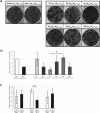Host-dependence of in vitro reassortment dynamics among the Sathuperi and Shamonda Simbuviruses
- PMID: 30896304
- PMCID: PMC6455117
- DOI: 10.1080/22221751.2019.1586410
Host-dependence of in vitro reassortment dynamics among the Sathuperi and Shamonda Simbuviruses
Abstract
Orthobunyaviruses are arboviruses (Arthropod Borne Virus) and possess multipartite genomes made up of three negative RNAs corresponding to the small (S), medium (M) and large (L) segments. Reassortment and recombination are evolutionary driving forces of such segmented viruses and lead to the emergence of new strains and species. Retrospective studies based on phylogenetical analysis are able to evaluate these mechanisms at the end of the selection process but fail to address the dynamics of emergence. This issue was addressed using two Orthobunyaviruses infecting ruminants and belonging to the Simbu serogroup: the Sathuperi virus (SATV) and the Shamonda virus (SHAV). Both viruses were associated with abortion, stillbirth and congenital malformations occurring after transplacental transmission and were suspected to spread together in different ruminant and insect populations. This study showed that different viruses related to SHAV and SATV are spreading simultaneously in ruminants and equids of the Sub-Saharan region. Their reassortment and recombination potential was evaluated in mammalian and in insect contexts. A method was set up to determine the genomic background of any clonal progeny viruses isolated after in vitro coinfections assays. All the reassortment combinations were generated in both contexts while no recombinant virus was isolated. Progeny virus populations revealed a high level of reassortment in mammalian cells and a much lower level in insect cells. In vitro selection pressure that mimicked the host switching (insect-mammal) revealed that the best adapted reassortant virus was connected with an advantageous replicative fitness and with the presence of a specific segment.
Keywords: Orthobunyavirus; arbovirus; reassortment; recombination; viral selection.
Figures








Similar articles
-
Genetic reassortment between Sathuperi and Shamonda viruses of the genus Orthobunyavirus in nature: implications for their genetic relationship to Schmallenberg virus.Arch Virol. 2012 Aug;157(8):1611-6. doi: 10.1007/s00705-012-1341-8. Epub 2012 May 16. Arch Virol. 2012. PMID: 22588368
-
The Potential for Reassortment between Oropouche and Schmallenberg Orthobunyaviruses.Viruses. 2017 Aug 11;9(8):220. doi: 10.3390/v9080220. Viruses. 2017. PMID: 28800086 Free PMC article.
-
Emergence of a natural reassortant between Shamonda and Sathuperi viruses of the species Orthobunyavirus schmallenbergense in Japan.Arch Virol. 2025 Feb 1;170(2):44. doi: 10.1007/s00705-025-06233-5. Arch Virol. 2025. PMID: 39893347
-
[ZOOPATHOGENIC ORTHOBUNIAVIRUSES (ORTHOBUNYAVIRUS, BUNYAVIRIDAE)].Vopr Virusol. 2016;61(2):53-8. Vopr Virusol. 2016. PMID: 27451495 Review. Russian.
-
Schmallenberg virus: a new Shamonda/Sathuperi-like virus on the rise in Europe.Antiviral Res. 2012 Aug;95(2):82-7. doi: 10.1016/j.antiviral.2012.05.014. Epub 2012 Jun 5. Antiviral Res. 2012. PMID: 22684044 Review.
Cited by
-
Circulation of Ngari Virus in Livestock, Kenya.mSphere. 2022 Dec 21;7(6):e0041622. doi: 10.1128/msphere.00416-22. Epub 2022 Dec 6. mSphere. 2022. PMID: 36472449 Free PMC article.
-
Endemic and Emerging Arboviruses in Domestic Ruminants in East Asia.Front Vet Sci. 2020 Apr 7;7:168. doi: 10.3389/fvets.2020.00168. eCollection 2020. Front Vet Sci. 2020. PMID: 32318588 Free PMC article. Review.
-
Combinatorial Minigenome Systems for Emerging Banyangviruses Reveal Viral Reassortment Potential and Importance of a Protruding Nucleotide in Genome "Panhandle" for Promoter Activity and Reassortment.Front Microbiol. 2020 Apr 8;11:599. doi: 10.3389/fmicb.2020.00599. eCollection 2020. Front Microbiol. 2020. PMID: 32322247 Free PMC article.
-
Genomic Detection of Schmallenberg Virus, Israel.Emerg Infect Dis. 2021 Aug;27(8):2197-2200. doi: 10.3201/eid2708.203705. Emerg Infect Dis. 2021. PMID: 34287129 Free PMC article.
-
Marine Oomycetes of the Genus Halophytophthora Harbor Viruses Related to Bunyaviruses.Front Microbiol. 2020 Jul 15;11:1467. doi: 10.3389/fmicb.2020.01467. eCollection 2020. Front Microbiol. 2020. PMID: 32760358 Free PMC article.
References
-
- Allison AB, Stallknecht DE, Holmes EC.. Evolutionary genetics and vector adaptation of recombinant viruses of the western equine encephalitis antigenic complex provides new insights into alphavirus diversity and host switching. Virology. 2015;474:154–162. doi:10.1016/j.virol.2014.10.024. - DOI - PMC - PubMed
MeSH terms
LinkOut - more resources
Full Text Sources
Other Literature Sources
